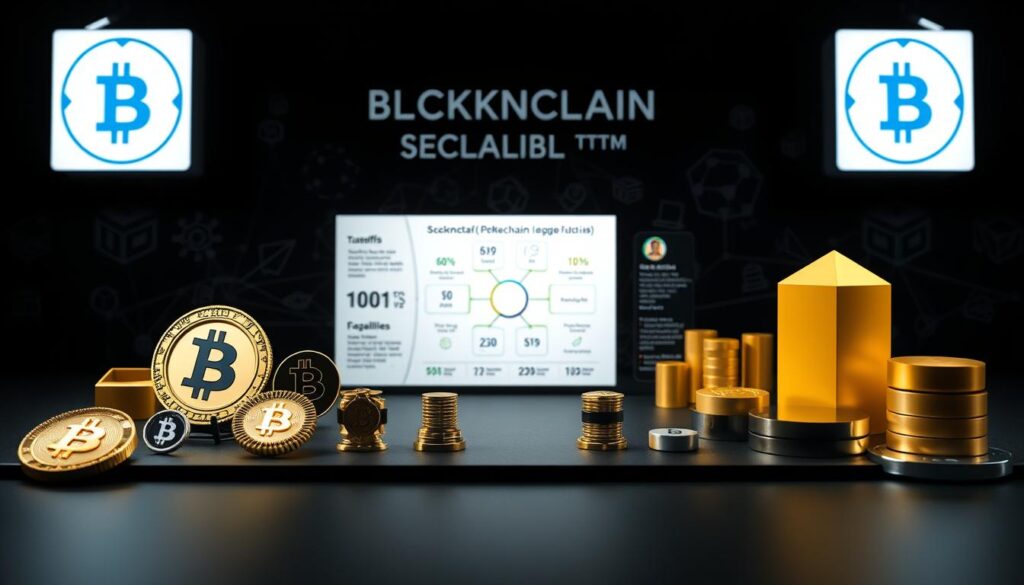Now Reading: DeFi Token Swaps: Secure and Efficient Trading Options
- 01
DeFi Token Swaps: Secure and Efficient Trading Options
DeFi Token Swaps: Secure and Efficient Trading Options

Modern digital asset trading has evolved beyond traditional methods. Blockchain technology now enables direct peer-to-peer transactions through automated systems. These platforms remove intermediaries, letting users trade assets securely while maintaining full control of their funds.
Unlike centralized marketplaces, decentralized systems use smart contracts to execute trades instantly. Liquidity pools replace order books, ensuring stable pricing even for less common assets. This approach minimizes fees while offering access to a broader range of trading pairs across multiple networks.
Advanced platforms like Symbiosis.finance simplify cross-network transactions through innovative solutions. Their system eliminates complex bridge processes, allowing users to swap assets between chains in a single step. The sToken mechanism prevents price slippage and avoids asset wrapping, delivering predictable outcomes for every trade.
Security remains paramount in these ecosystems. Failed transactions trigger automatic refunds in stablecoins, protecting users from lost funds. This reliability feature sets new standards for trust in decentralized trading environments.
Key Takeaways
- Decentralized trading systems use smart contracts instead of middlemen
- Liquidity pools enable stable pricing for diverse crypto assets
- Cross-chain swaps eliminate complex bridging processes
- Automated refunds protect users during failed transactions
- Lower fees and broader asset selection compared to traditional exchanges
Introduction to Decentralized Finance and Token Swaps

Cutting-edge technology enables direct asset exchanges without intermediaries. This innovation reshapes how people trade digital currencies, offering faster transactions and enhanced privacy. Users now bypass centralized authorities through automated systems built on blockchain networks.
What Are Token Swaps?
A token swap lets you trade one cryptocurrency for another instantly. Imagine converting Ethereum to Chainlink directly through a digital wallet. These transactions occur through smart contracts instead of traditional brokers.
Platforms like decentralized exchanges handle these swaps using liquidity pools. Users contribute funds to these pools, earning fees while enabling seamless trades. This system removes price manipulation risks common in conventional markets.
The Role of Decentralized Exchanges
These platforms operate 24/7 with no geographical restrictions. You connect your wallet, choose assets, and confirm the trade – no lengthy signups. Non-custodial systems ensure you retain full control of your crypto throughout the process.
Advanced algorithms calculate fair prices based on pool liquidity. This method prevents sudden price drops during large transactions. Transparent blockchain records let anyone verify trade details, building trust in the ecosystem.
The Fundamentals of DeFi Technology
Financial systems are undergoing a radical transformation through blockchain integration. This shift replaces legacy banking frameworks with transparent, code-driven networks that operate globally. Trustless protocols now handle transactions through mathematical verification rather than human oversight.

Blockchain Integration in Finance
Traditional finance relies on centralized databases controlled by institutions. Blockchain flips this model by distributing transaction records across thousands of computers. Every swap or transfer gets timestamped and linked in an unchangeable chain of data blocks.
Smart contracts power this revolution. These self-executing agreements automatically transfer assets when preset conditions meet. For example, a trade completes only if both parties’ wallets contain sufficient funds, eliminating manual checks.
- Real-time settlements occur 24/7, bypassing banking hours and holiday closures
- Network participants collectively verify transactions through consensus mechanisms
- Open-source code allows anyone to audit platform operations and pricing models
Platforms like Uniswap demonstrate this innovation. Their automated market makers use liquidity pools instead of order books, calculating prices through algorithmic formulas. This approach prevents manipulation while supporting thousands of decentralized finance assets.
The system’s resilience comes from its distributed nature. No single outage or hack can halt operations since data exists across multiple nodes. This architecture meets growing demand for financial services that prioritize accessibility over geographic boundaries.
Understanding DeFi Token Swaps
Digital trading ecosystems have transformed how assets move across networks. At their core lies a partnership between algorithmic pricing systems and community-driven reserves. These components work together to enable seamless exchanges while maintaining fair market rates.

How Algorithmic Pricing Systems Operate
Traditional exchanges rely on order books to match buyers and sellers. Modern platforms use mathematical models instead. These systems calculate prices based on asset ratios in reserve pools, adjusting rates instantly as trades occur.
Sophisticated formulas prevent drastic price swings during large transactions. They balance supply and demand automatically, ensuring consistent pricing. This approach removes reliance on human market makers while operating 24/7.
Community-Driven Reserve Networks
Asset reserves form the backbone of decentralized trading platforms. Participants deposit pairs of digital currencies into shared pools. These reserves allow instant exchanges without waiting for counterparties.
Contributors earn fees from every completed transaction. Some platforms offer bonus rewards to encourage participation. As more people join, reserves grow deeper – improving trade execution for everyone.
Smart contracts manage these pools autonomously. They enforce deposit rules and distribute earnings fairly. This system creates transparent markets where anyone can verify transaction histories.
How Automated Market Makers and Smart Contracts Work
Digital trading systems now rely on self-operating protocols to maintain fair pricing and instant transactions. These mechanisms combine mathematical precision with blockchain security, creating reliable environments for asset exchanges.
Exploring AMM Mechanisms
When you exchange crypto assets like USDC for ETH, an automated market maker calculates rates using pool reserves. Platforms apply formulas like x * y = k – where x and y represent available assets. This equation keeps the product constant, adjusting prices as reserves shift.
Smart contracts handle every step without human input. They verify wallet balances, execute trades, and update liquidity pools instantly. This automation removes errors while preventing third-party interference.
Price adjustments happen naturally through supply changes. If ETH reserves drop, its value increases proportionally. This system mirrors real-world demand without centralized oversight.
- Algorithmic pricing maintains fairness across all transactions
- Decentralized liquidity pools replace institutional market makers
- Transparent contract code lets anyone audit trading rules
These systems handle heavy trading volumes efficiently. Continuous operation ensures 24/7 access to crypto markets. Users benefit from predictable fees and real-time rate adjustments based on current activity.
Step-by-Step Guide for Secure Token Swaps
Executing digital asset transactions securely requires careful preparation and precise actions. This guide outlines essential protocols to protect your funds while navigating decentralized trading platforms.
Connecting and Securing Your Crypto Wallet
Start by accessing a trusted platform like Symbiosis WebApp. Verify the website URL matches official sources to avoid phishing scams. Popular wallets like MetaMask integrate seamlessly but require careful permission management.
Enable two-factor authentication and create backups of recovery phrases. Never share private keys or seed phrases, even with support teams. These steps form your first defense against unauthorized access.
Initiating and Confirming a Swap
Select your source asset (e.g., USDC) and desired destination currency (like BNB). Choose blockchain networks for both origin and target chains. Review network fees and slippage tolerance before proceeding.
Confirm these critical details before finalizing:
- Exact token amounts and conversion rates
- Destination wallet address accuracy
- Estimated gas fees across both networks
Monitor transaction status through blockchain explorers after confirmation. Failed transfers automatically refund through stablecoins, but proper verification prevents most issues.
Choosing a Reliable DeFi Platform for Swaps
Navigating decentralized trading requires finding platforms that balance security with efficiency. Start by verifying third-party audits of smart contracts – reputable firms like CertiK or OpenZeppelin often conduct these evaluations. Platforms with active bug bounty programs demonstrate commitment to resolving vulnerabilities quickly.
Liquidity depth determines how smoothly your transactions process. Deep reserves in currency pools prevent price slippage, especially for large trades. Check real-time liquidity metrics through blockchain explorers before initiating exchanges.
User-friendly interfaces reduce costly mistakes. Look for platforms offering clear transaction previews and confirmation screens. Some services integrate with best crypto staking platforms, creating additional earning opportunities alongside trading features.
Four critical factors for platform selection:
- Multi-chain support for accessing diverse digital assets
- Transparent fee structures without hidden costs
- 24/7 operational uptime tracked through independent monitors
- Active community forums discussing platform updates
Review historical performance during market volatility. Reliable systems maintain transaction speeds even when trading volumes spike. Combine technical analysis with user testimonials to gauge real-world reliability before committing funds.
Best Practices to Minimize Fees
Mastering fee efficiency separates successful traders from the rest. Transaction costs can accumulate quickly, but smart strategies keep expenses manageable. Start by timing your exchanges during off-peak hours when network congestion eases. Blockchain activity often slows overnight, creating windows for lower-cost transactions.
Select blockchain networks known for affordable gas fees. Platforms supporting multiple chains let you choose cost-effective options. Always compare real-time fee estimators before confirming trades. Some systems offer dynamic pricing that adjusts based on current demand.
Consolidate smaller transactions into larger batches. This approach spreads fixed network costs across multiple trades. Explore layer-2 solutions that process transactions outside main networks, slashing fees by up to 90%. Tools like aggregators scan multiple liquidity sources automatically, finding optimal rates.
Regularly review platform fee structures. Many services charge percentage-based rates that vary between assets. Update wallet settings to set maximum acceptable slippage, preventing costly price mismatches. Stay informed about network upgrades – newer protocols often introduce enhanced cost-saving features.
These methods create sustainable trading habits. Reduced expenses mean more capital remains working for you. Combine technical awareness with disciplined execution to maximize returns across every exchange.
FAQ
How do decentralized exchanges differ from traditional ones?
Decentralized exchanges (DEXs) like Uniswap or SushiSwap operate without intermediaries, allowing direct peer-to-peer trading via smart contracts. Unlike centralized platforms such as Coinbase, users retain control of their assets through self-custodied wallets, reducing counterparty risk.
What makes automated market makers essential for crypto trades?
Automated market makers (AMMs) use liquidity pools instead of order books to determine asset prices. Platforms like Curve Finance rely on this model, enabling instant trades and continuous liquidity even for less popular assets.
Why are gas fees a critical factor in blockchain transactions?
Gas fees compensate miners or validators for processing transactions on networks like Ethereum. During peak congestion, these costs can spike significantly. Optimizing transaction timing or using layer-2 solutions like Arbitrum helps reduce expenses.
How do liquidity providers earn passive income?
By depositing assets into pools on platforms such as Balancer, providers earn a share of trading fees proportional to their contribution. This incentivizes participation and ensures sufficient liquidity for seamless swaps.
What security measures protect crypto wallets during swaps?
Hardware wallets like Ledger or Trezor offer offline storage for private keys, minimizing exposure to hacks. Always verify contract addresses and avoid approving unlimited spending permissions when interacting with dApps.
Can smart contracts guarantee error-free transactions?
While smart contracts automate processes without intermediaries, they’re only as reliable as their code. Audited platforms like Aave reduce risks, but users should research protocols to avoid vulnerabilities or exploits.
How do cross-chain swaps expand trading opportunities?
Bridges like Thorchain or Synapse enable asset transfers between blockchains, letting users trade Bitcoin for Ethereum-based tokens. This interoperability breaks down silos, fostering a more connected ecosystem.
What role do oracles play in decentralized finance?
Oracles like Chainlink feed real-world data into blockchain networks, ensuring accurate price feeds for assets in liquidity pools. This prevents manipulation and maintains fair valuation during trades.














